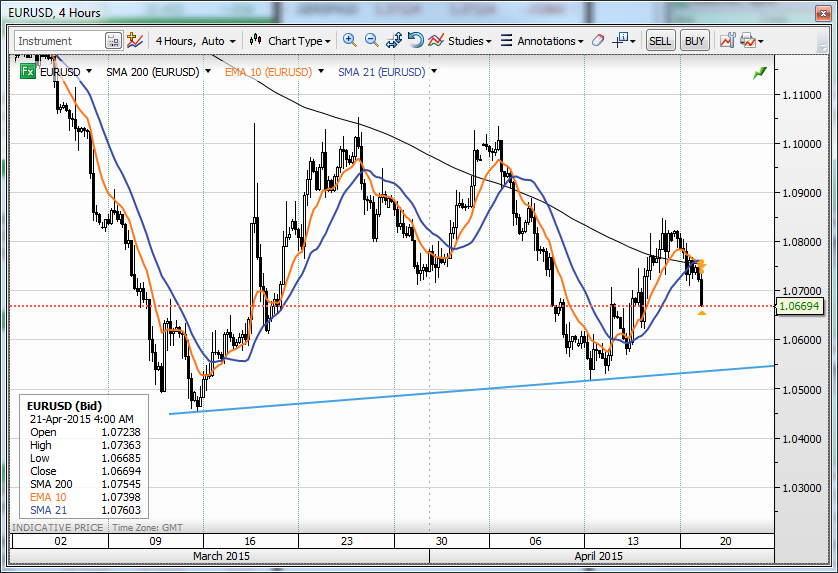The Reserve Bank of Australia minutes overnight offered relatively dovish guidance after comments by governor Glenn Stevens were published yesterday, in which he declared that the AUD is likely to fall further.
Those comments weakened the AUD more than the minutes overnight, which generally failed to shift rate expectations notably. We first reached current levels in AUDUSD in late January, so, AUD has effectively been doing nothing but range trading for almost three months.
The USD managed a comeback yesterday from key support levels, but one wonders at the potential for the greenback to take flight beyond recent ranges ahead of next Wednesday’s Federal Open Market Committee meeting. And what data since the last meeting suggests that the Fed should do anything but declare “pass”?
The upside counter-argument for the USD is that the market is already extremely dovish in its expectations and that the Fed may choose once again to lean against too much complacency and prefer to keep all options on the table.
Today’s economic calendar offers a German ZEW survey, though the focus in Europe is squarely on Greece and EU periphery contagion as Greek 3-year yields have pushed higher again closing yesterday above 28%.
The difference relative to late last week when the euro rallied is that developments didn’t affect general risk sentiment, so the euro was able to sell off (in alignment with the carry trade theme).
Chart: EURUSD 4-hour
EURUSD has pushed below the important 1.0700 area this morning on fresh news that the ECB is considering whether it should tighten the ELA assistance parameters. The next major level is the rising line of consolidation above 1.0500.

USD: The greenback had its back against the wall yesterday in key pairs and has made a comeback, but big picture, can it rally much further in a data vacuum and with the FOMC likely to say very little at next week’s meeting? Of course, it can rally by default on negative news elsewhere as we’re seeing in EURUSD this morning, but let’s watch 119.50/120.00 in USDJPY and 1.0500 in EURUSD for next steps.
EUR: Focus should be on risk appetite (assumption being that euro trades in negative correlation with said appetite) and on developments in Greece and the degree to which these continue to aggravate peripheral spreads. Actual economic data out of Europe may receive little attention. Just as we are about to post this, we get ECB statements that the ECB is looking at ways to increase the haircut on ELA assistance to Greece as a “growing minority” apparently oppose the ELA assistance.
JPY: Sold off yesterday as USDJPY bounced from key support, while other JPY crosses traded more heavily. Japan’s prime minister Shinzo Abe will be traveling to the US from April 26 to May 3, so don’t look for the least hint of new policy easing initiatives from political or BoJ quarters during this time period!
GBP: GBPUSD has edged lower to the first key Fibonacci support in the 1.4870 area, with further support down toward 1.4750 if the USD continues to rally. If not, a smart rally will pique interest in a fresh attempt higher through 1.5000. Remember the election coming up on May 7.
CHF: The slide lower in EURCHF seems to be on rails, as we watch for the channel lower to break before we can call a bottom. Price action suggests 1.0250 might be a bit of a hurdle at the moment. In USDCHF, the key support is the 200-day moving average and range lows in the 0.9500 area.
AUD: Weaker still overnight on the RBA minutes, as the AUDUSD rally looks thoroughly compromised now, though there’s still a 61.8% Fibonacci retracement to deal with at 0.7665 if we’re to expect an immediate push to the cycle lows. AUD also weak in the crosses as the AUDNZD parity test scenario is back in play.
CAD: The selloff has lost some momentum, but the 1.2270 area has turned into a zone of resistance for now and Canadian 2-year swap rates are back above 1.00% and the spread to US rates remains near the lows since mid-February, so the pressure may remain to the downside unless we get a more significant selloff in oil prices.
NZD: Watching parity in AUDNZD and the 0.7600 area in NZDUSD for whether NZD maintains its impressive recent strength.
SEK: Watching unemployment rate release today for whether it serves as a catalyst as 9.2250-9.40 is the range for the moment in EURSEK.
NOK: EURNOK resistance ahead of 8.50 is the focus as we watch whether we hold in this lower range.
Upcoming economic calendar highlights (all times GMT)
- Sweden Mar. Unemployment Rate (0730)
- Germany Apr. ZEW Survey (0900)
- Eurozone Apr. ZEW Survey (0900)
- Hungary Central Bank Rate Decision (1200)
- Eurozone ECB’s Nouy to Speak (1630)
- Japan Mar. Trade Balance (2350)
- Australia Q1 CPI (0130)
